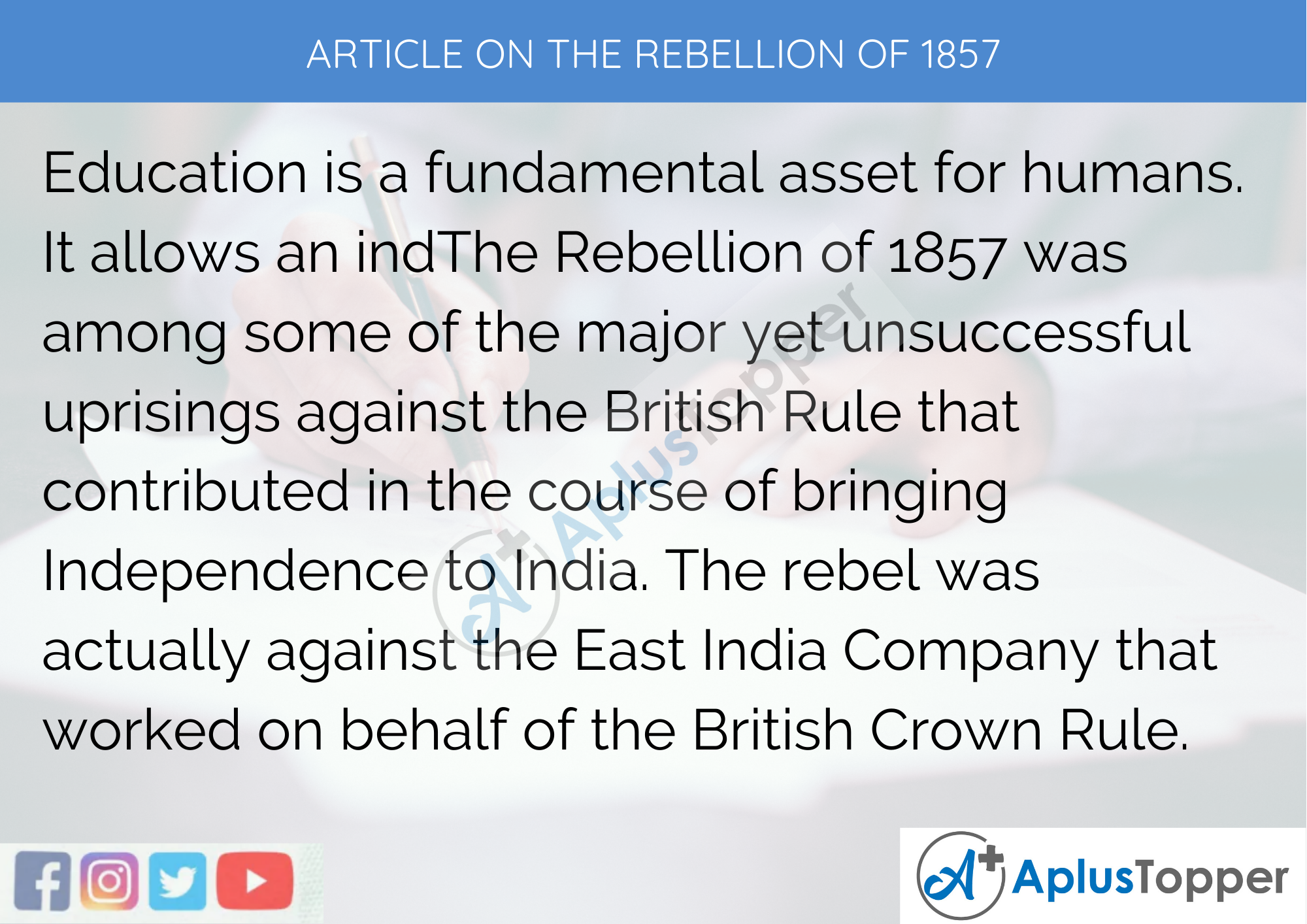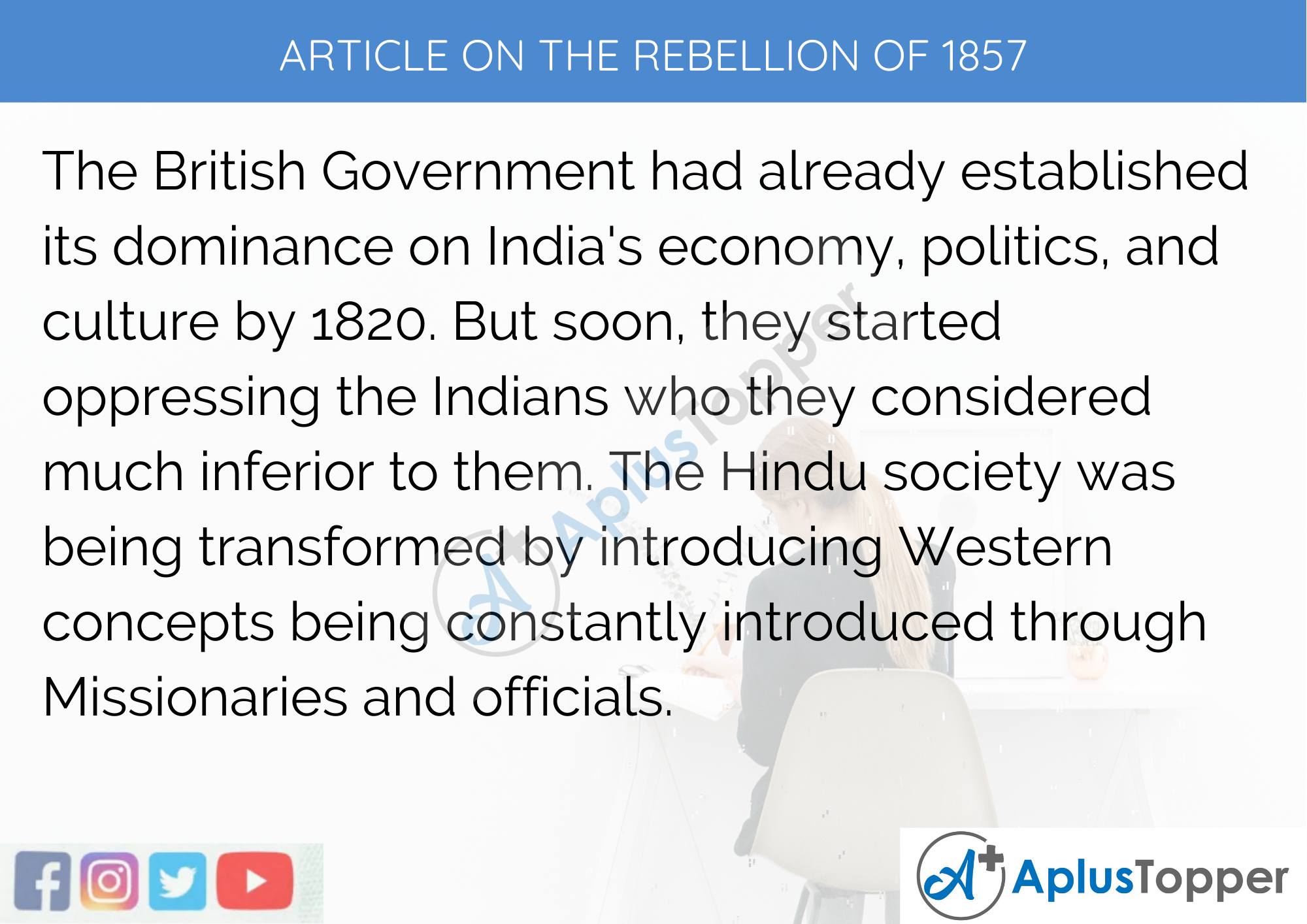Article On The Rebellion Of 1857: The Sepoy Mutiny is the popular name of the Rebellion of 1857. This was the first massive rebellion fought for Indian Independence when masses united to rebel against the British Government in 1857.
It is said that the rebellion started from Meerut on 10th May of the year 1857. But eventually, for many reasons, the rebellion took an unexpected turn to start the Sepoy Mutiny.
The oppression of Britishers on the Indians was the major reason for giving rise to this and many other rebellions. The rebellion, though, turned to be a failure to bring complete Independence. The rebellion did, however, bring forth several unprecedented crucial changes to the British rule.
You can read more Article Writing about people, sports, technology many more.
Long And Short Articles On The Rebellion Of 1857 for Students and Children in English
The Rebellion of 1857 is an important topic in the history of Indian Independence. At one time or another, the students will be required to write about this topic in their assignments and exams. The long articles are useful for students of classes 7, 8, 9, and 10. And the short articles will come in handy for students of classes 1, 2, 3, 4, 5, and 6.

Long Article On The Rebellion Of 1857 500 Words in English
The Rebellion of 1857 was among some of the major yet unsuccessful uprisings against the British Rule that contributed in the course of bringing Independence to India. The rebel was actually against the East India Company that worked on behalf of the British Crown Rule.
Many mistakes the Rebellion of 1857 to be the first rebellion of the country against British Rule. But the truth is that many small regional rebellions had already occurred before the 10th May of 1857. And all these small uprisings indicated that agitation among Indians had started throughout the country.
Some of the mentionable revolts that occurred before the Rebellion of 1857 are the Sanyasi Revolt, The Jungle Mahal Rebellion (1767), Nayak Rebellion, Chuad Rebellion, Santhal Rebellion, the Second Military Rebellion of Bengal (1795), the Vellore’s Rebellion (1803), the Great Rebellion of 1824, Mahikant Rebellion of Gujarat (1836), and Military uprising of 1855.
But it was the Rebellion of 1857 that recorded the most unified support from the Indian population. It was not one reason that caused such massive uprising. Rather the people had multiple reasons to revolt against the British Government by then.
Some of the causes of the revolt were the Britishers looting Indians of their rightful properties like land and imposing an excessive amount of taxes on the people. The sense of fear among regional rules heightened with the introduction of the Doctrine of Lapse by Dalhousie.
The orthodox conservative families of India were also threatened when Britishers started banning some of the then social norms. Other than this, the Indians working in the military of the British Government were treated very poorly.
One of the major incidents that enraged the Indian people, including Mangal Pandey and his mates, was that the British made them use cow and pig fat covered of bullets. These bullet covers were required to be broken using teeth, and the army did so. The British did this, knowing that it would be going against most people’s religious beliefs in India.
The Britishers imprisoned those who did not use those bullets and also hanged them. Thus such injustice gave rise to rebellions in several parts of India. And the Rebellion of 1857 did start in Meerut when the arrested soldiers broke out of the jail and killed several British officers.
The revolt was led by Dhan Singh Gurjar, who was a Katowal in the British army himself. The revolting soldiers went to Delhi to spread the notion of revolt. And they succeeded in doing so because the revolt started in other parts of India as well.
The Britishers were stunned since they were outnumbered compared to the number of Indian soldiers in the British Army who were all revolting. But the British Government wasn’t letting the satiation get the best of them so easily, so they played dirty politics by using several tactics.
Lord Canning ultimately suppressed the Rebellion of 1857. It was because the tactics of the British Government succeeded in creating a massacre as they lured Sikh and Madrasi soldiers in their favor.
Short Article On The Rebellion Of 1857 300 Words in English
The British Government had already established its dominance on India’s economy, politics, and culture by 1820. But soon, they started oppressing the Indians who they considered much inferior to them. The Hindu society was being transformed by introducing Western concepts being constantly introduced through Missionaries and officials.
The officers of East India Company working under the British Crown started replacing the aristocracy of the Indian princely states. This was done by introducing several tactics. One of those popular unfair tactics was introducing the Doctrine of Lapse that stated the abdication of land when a king without a male natural heir dies.
Many such reasons were behind what ignited the fire of rebel in the Indian public, but the controversy involving the use of Enfield rifle worked as the last spark of fire to the hay.
The issue was that the ends of the bullets used in the newly introduced Enfield rifle needed to be torn off using teeth. But these bullets were lubricated or greased using cow’s and pig’s lard. And having oral contact with cow’s and pig’s lard was against the religious beliefs of Hindu and Muslims, respectively.
Since the British officials ignored the discomfort, this issue caused the Indians to serve in their army and enraged the public. It was a matter of time that many such discontents build up to become a unified, strong objective for rebelling against the British Rule.
Indian soldiers from across India took part in the Rebellion of 1857, and the lives of many British officers were taken in this while. But soon, the British Government found a way to suppress this nationwide revolt by convincing Sikh and Madrasi soldiers to fight on their behalf. Even though the Rebellion of 1857 turned out to be a failure, but it left a deep impact that forced the British Government to bring certain changes.

10 Lines On Article About The Rebellion Of 1857
- The British capturing the Indians’ lands and increasing the amount of tax massively led to the conditions of hunger and poverty in the country.
- The East India Company also was eager to spread Christianity among Indians, and that is why they disregarded people of other religions.
- Mangal Pandey was among the first who refused to the bullets of Enfield rifle.
- Many British officers were shot by Mangal Pandey when they tried to capture him, but eventually, he was arrested and later hanged.
- The Rebellion of 1857, since it was not much unified, it was one of the reasons it failed to serve its purpose.
- The British Government had better modern ammunitions, which helped them suppress the uprising.
- The lack of good transportation and cooperation among the Indian soldiers from different parts of India was among the major causes of the failure of Sepoy Mutiny.
- After the Sepoy Mutiny, the British Crown took away the power from the East India Company to rule in India.
- It was during the revolt, and after that, Indians realized the brotherhood amongst themselves.
- The revolt also brought changes in the British Army when the ratio of Indians to British soldiers was reduced from 5:1 to 2:1.
FAQ’s on Article on The Rebellion of 1857
Question 1.
What did the Doctrine of Lapse demand?
Answer:
The Doctrine of Lapse introduced by Dalhousie stated that a kingdom must have a natural-born rightful male heir, or else the East India Company would capture the kingdom.
Question 2.
Who took charge of the rule in India after the Rebellion of 1857?
Answer:
Queen Victoria took the power of the Government of India from the East India Company after the revolt of 1857. And the post of Viceroy was introduced, replacing the post of Governor-General.
Question 3.
State one reason why the Rebellion of 1857 failed?
Answer:
One of the most important reasons behind the failure of the Rebellion of 1857 is Sikh and Madrasi soldiers working in favor of the British Government and fighting against the brothers of their own country.
Question 4.
Who was Mangal Pandey, and what is his role in the Sepoy Mutiny.
Answer:
Mangal Pandey was a soldier in the British army. When he revolted about the Enfield rifle bullets, he was stationed in Barackpore of West Bengal. He is one of the first soldiers to rebel against British troops, which marked the as a significant event in the Sepoy Mutiny.
